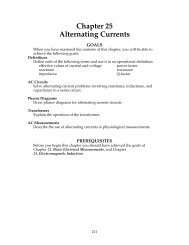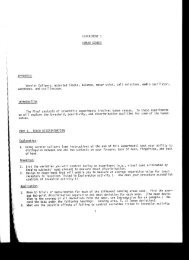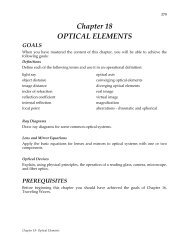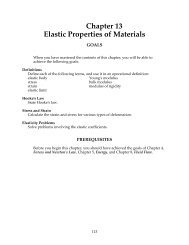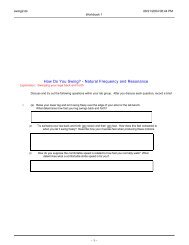Create successful ePaper yourself
Turn your PDF publications into a flip-book with our unique Google optimized e-Paper software.
Shoe friction w-force plate.dsWorkbook 107/13/2004 04:47 PM3. A. Does the maximum force of static friction between two surfaces have a relationship with the characteristics of the surfaces? (Ifthe surfaces change does the maximum force of static friction change?)B. Does the force of kinetic friction between two surfaces have a relationship with the characteristics of the surfaces?(If the surfaces change does the force of kinetic friction change?)- 6 -
E.T.S. DE INGENIEROS DE CAMINOS, CANALES Y PUERTOSGRADO EN INGENIERÍA DE OBRAS PÚBLICAS- UNIVERSIDADE DA CORUÑACALENDARIO ESCOLAR DEL CURSO 2013/20149 de septiembre : Inicio de las clases (1 er cuatrimestre)7 de octubre : Festivo (Virgen del Rosario)12 de octubre1 de noviembre: Festivo (Fiesta nacional de España): Festivo (Día de Todos los Santos)6 de diciembre20 de diciembre: Festivo (Constitución Española): Último día de clases (1 er cuatrimestre)21 de diciembre al 7 de enero : Vacaciones de Navidad13 al 25 de enero : Periodo de exámenes (cierre actas: 7 de febrero)27 de enero : Festivo por traslado (Santo Tomás de Aquino)28 de enero : Inicio de las clases (2º cuatrimestre)3 y 4 de marzo : Festivos (Lunes y martes de carnaval)12 al 21 de abril : Vacaciones de Semana Santa1 y 2 de mayo : Festivo (Día del trabajo)12 de mayo : Festivo (Sto. Domingo de la Calzada)16 de mayo : Último día de clase en todos los cursos (2º cuatrimestre)19 de mayo al 5 de junio : Periodo de exámenes 2º cuatrimestre (cierre actas: 17 de junio)1 al 18 de julio : Periodo de exámenes finales (cierre actas: 28 de julio)
Shoe friction w-force plate.dsWorkbook 107/13/2004 04:47 PMMeasuring the Normal ForceYou will measure the normal force of the floor on your shoe using the force plate. Determine what the force platereads before you put your shoe on it - in case you need to calibrate your measurements accordingly.@ Force Plate, Ch BNo DataForce Plate B-------N@ Voltage, ChB No Data blue 1.389 1.182. 947 .78650 0Voltage-------Vgreen 1.275 1.078Yellow 1.281 1.083red 1.788 1.591- 9 -
Shoe friction w-force plate.dsWorkbook 107/13/2004 04:47 PMDetermining the Friction forceLet’s model the force of your foot pushing back on your shoe with a force sensor pulling back on your shoe.You are going to pull slowly with the force sensor just until the shoe moves. (This will be recorded by a motion sensor,that will indicate when the shoe starts to move). Then you will pull the shoe at constant velocity.Force of your foot on your shoeOn the whiteboard draw the free-body diagram of all the forces acting on the shoe when the shoe isn't moving whileit is being pulled back by your foot (force sensor).How does the force sensor measurement relate to the static friction force?On the whiteboard draw the free-body diagram of all the forces acting on the shoe when the shoe is moving atconstant velocity while being pulled back.How does the force sensor measurement relate to the kinetic friction force?- 10 -
Shoe friction w-force plate.dsWorkbook 107/13/2004 04:47 PMThe correct way for the shoe to be pulled <strong>and</strong> connected is as shown.Make sure you pull horizontally, in line with the forcesensor. The force sensor will only read accuratelywhen its hook is pulled or pushed straight in or out.Some common mistakesHolding the Force Sensor at an angle to the string.Pulling the shoe at an angle up.Pulling the shoe at an angle sideways- 11 -
Shoe friction w-force plate.dsWorkbook 107/13/2004 04:47 PMWhen the shoe is being pulled,the friction that preventsmovement is static friction. Afterthe shoe begins to move thefriction that resists the motion iskinetic friction. Both of thesetypes of friction are due to theparallel component of the force ofthe floor pushing on the shoe. Inthe case of kinetic friction,however, the pull on the shoe isstrong enough to overcome thisWhich parts of the graph involvestatic friction (shoe not moving)<strong>and</strong> which involve kinetic friction(shoe moving)?Determine the point on the graphat which the shoe begins to move- how does the force sensorreading change? What is themaximum force in N?15@ Force, Ch A No Data10( N )5-2 2 4 6 8 10 12 14 16 18 20 22 24 26 28-5Time( s )-10-153.0@ Velocity, Ch 1&2 No Data( m/s )2.01.0-2 2 4 6 8 10 12 14 16 18 20 22 24 26 28-1.0Time( s )-2.0-3.0- 12 -
Shoe friction w-force plate.dsWorkbook 107/13/2004 04:47 PMYou are going to investigate static friction first.Whiteboard ActivityOn your whiteboard draw a sketch of the shoe. Draw <strong>and</strong> label all the forces acting on the shoe when it is not moving while it is beingpulled. Make sure the force vectors have the appropriate direction <strong>and</strong> magnitude.Physics Concept: All forces acting on an object (a system) must be balanced, if that object is not moving.Your instructor may show you how to draw the force vectors in a style commonly called a free body diagram. If your free-body diagramcorrectly shows how the forces are balanced, you can explain how you can obtain the static frictional force, acting on the shoe, from theforce sensor readings.One variable that you may have considered is your body weight…that the heavier you are the more force it takes to sllde your shoeacross the floor.You can check out this idea by putting at least four different weights in your shoe <strong>and</strong> seeing what force is required to just get the shoeto start movingThe weight of the shoe plus weights in the shoe in this case balances out the perpendicular component or “normal force” component ofthe force of the floor on the shoe..b. Knowing the weight of the shoe, how are you able to obtain the force on the shoe from the table or floor perpendicular to thefloor/shoe surface (normal force)? What is the value of this "normal" force?b. Knowing the weight of the shoe how are you are able to obtain the force on the shoe fromthe table or floor perpendicular to the floor/shoe surface (normal force)? What is the value ofthis "normal" force.- 13 -
Shoe friction w-force plate.dsWorkbook 107/13/2004 04:47 PMPut ~500kg into your shoe.Slowly pull with the force sensor until the shoe moves. (This will be recorded by a motion sensor).9.08.07.06.05.04.03.02.0( N )@ Force, Ch A No DataTime( s )0.5 1.0 1.5 2.0 2.5 3.0 3.5 4.0 4.5 5.0 5.5 6.0@ Force Plate, Ch B No DataForce Plate B------- N0.50@ Position, Ch 1&2 No Data0.400.30( m )0.200.10Time( s )0.5 1.0 1.5 2.0 2.5 3.0 3.5 4.0 4.5 5.0 5.5 6.0You will be recording the maximum static friction <strong>and</strong> the normal force in the table on page 16.Repeat this three times adding an additional 1kg (or so) amount each time. Record the maximum static <strong>and</strong> the normal forcefor each run. Do this for both surfaces.AMax Static vs Normal -surface 1DataNormal( N )Friction max( N )0.0000.0000.000 0.0000.000 0.0000.000 0.00015.039 0.000DMax Static vs Normal - surface 2DataNormal( N )Friction max( N )0.000 0.0000.000 0.0000.000 0.0000.000 0.0000.000 0.000- 14 -
Shoe friction w-force plate.dsWorkbook 107/13/2004 04:47 PMTry on a different surface. Compare with the graph of the first surface0.600.550.500.450.400.350.300.25Position( m ) @@ Position, Ch 1&2 No Data0.20Time( s )-0.5 0.5 1.0 1.5 2.0 2.5 3.0 3.5 4.0 4.5 5.0 5.5 6.0 6.50.15@ Force Plate, Ch B No DataForce Plate B------- N@ Force, Ch A No Data10Force( N ) @8642Time( s )-0.5 0.5 1.0 1.5 2.0 2.5 3.0 3.5 4.0 4.5 5.0 5.5 6.0 6.5- 15 -
Shoe friction w-force plate.dsWorkbook 107/13/2004 04:47 PMGraph the maximum static friction vs. normal force for each surface. Include the weight of the shoeMax Static vs Normal -surface 1DataNormal( N )Friction max( N )0.000 0.0000.000 0.0000.000 0.00015.039 0.0000.00108.0000e-46.0000e-4( N )4.0000e-4A Max Static vs Normal -surface 1 DataD Max Static vs Normal - surface 2 Data2.0000e-4@@ADMax Static vs Normal - surface 2DataNormal( N )Friction max( N )0.000 0.0000.000 0.0000.000 0.0000.000 0.0000.000 0.000-1 1 2 3 4 5 6 7 8 9 10 11 12 13 14 15 16-2.0000e-4Normal( N )-4.0000e-4-6.0000e-4-8.0000e-4-0.0010MinimumMaximumMeanCount0.0000.0000.0005Are the graphs linear? If they are, find the slope of each graph, using the user defined fit <strong>and</strong>0.000 check answer with the curve fit .0.0000.0005 graph 1 graph 2- 16 -
Shoe friction w-force plate.dsWorkbook 107/13/2004 04:47 PMCompare slopes.Surface 1The slope of the maximum static friction vs. normal force is called the coefficient of static friction for that particular shoe/floor surface.What does the slope tell you about the shoe/surface?Explain in your own words what the coefficient of friction means.Since there is a linear relationship between the force required <strong>and</strong> the normal force, we can represent this graph as an equationwhere the slope of the line is a constant number. This constant is called the coefficient of friction <strong>and</strong> is represented by thesymbol µ .When the friction is static, we can determine the static coefficient of friction, <strong>and</strong> when the friction is kinetic, we can determine the- 17 -
Shoe friction w-force plate.dsWorkbook 107/13/2004 04:47 PMDetermine the coefficients of friction for your shoe on both surfaces <strong>and</strong> compare the results. How do the two coefficients of friction(static, <strong>and</strong> kinetic, ) compare, for a given surface?- 18 -






